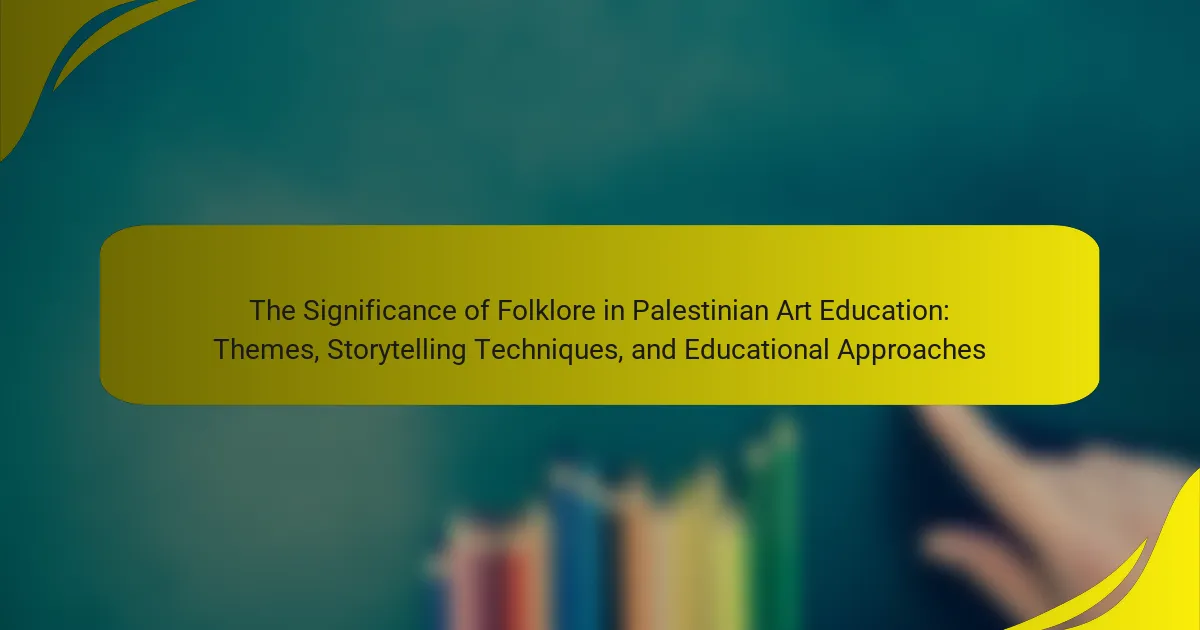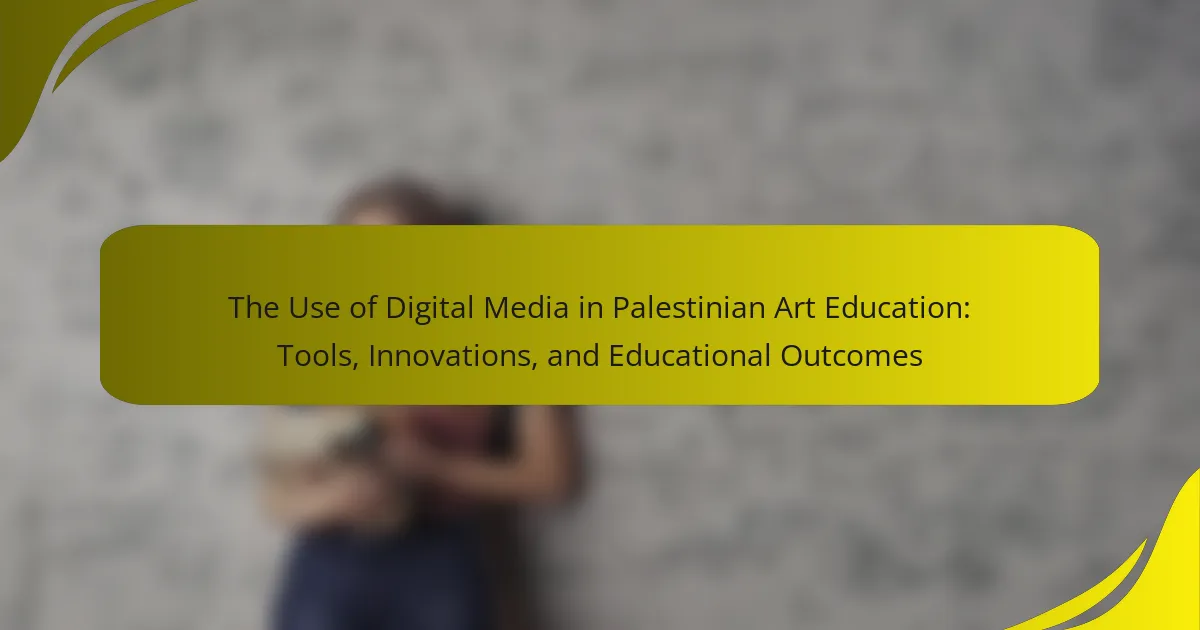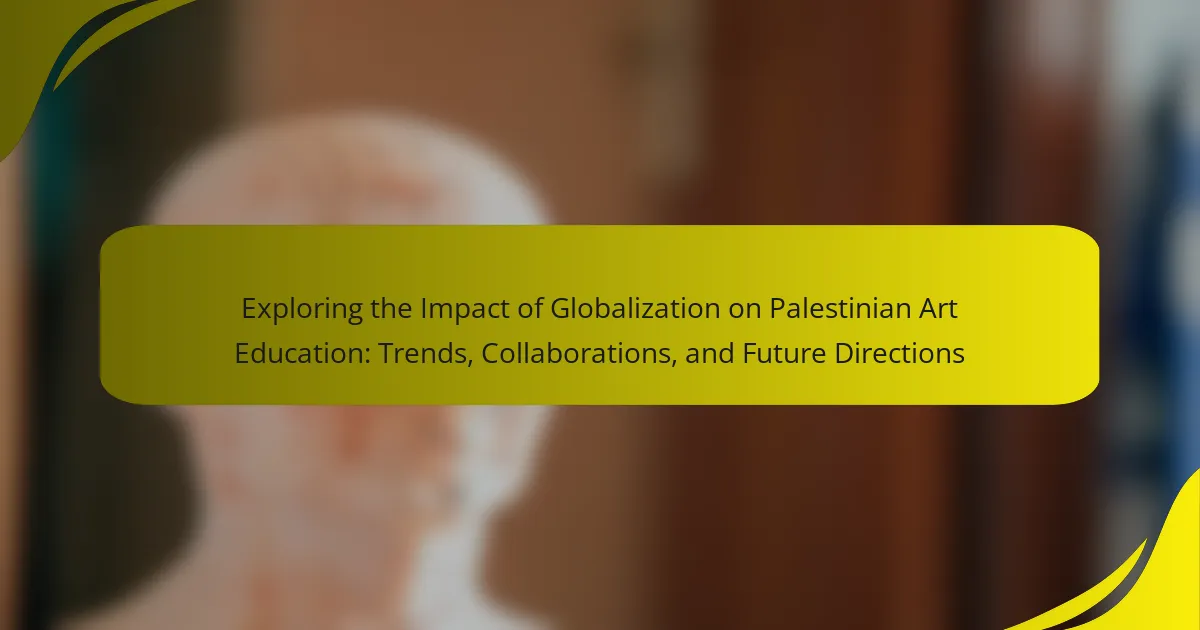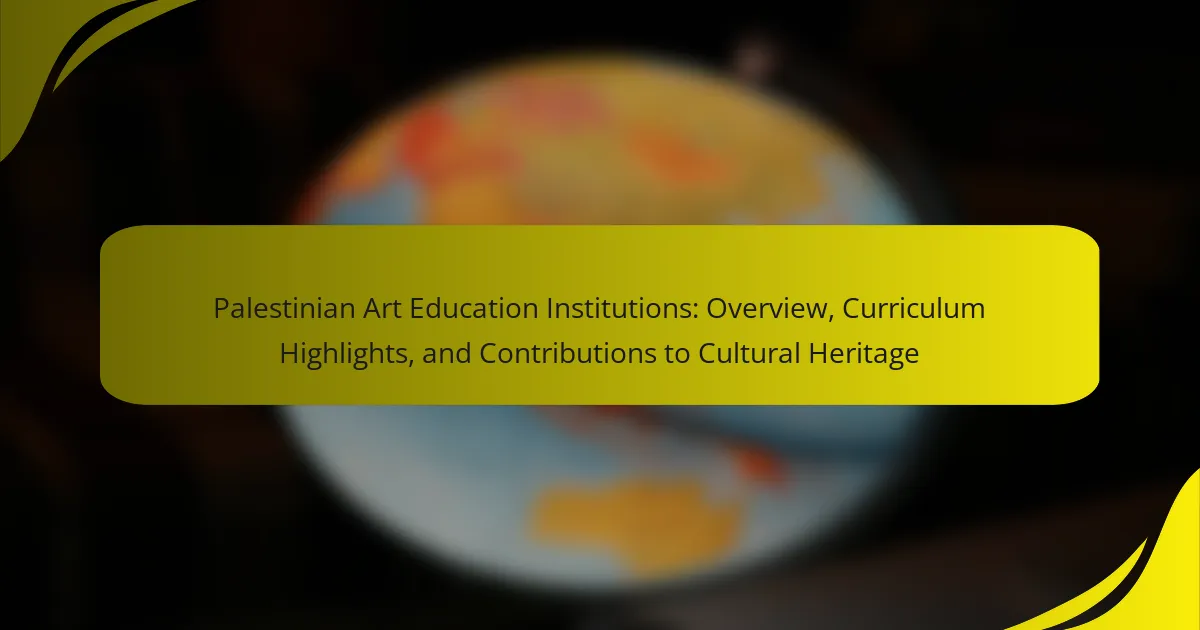Women are integral to Palestinian art education, serving as educators, artists, and advocates for cultural expression. Despite facing significant sociopolitical challenges and limited access to resources, they have pioneered initiatives that enrich the artistic landscape and foster resilience and cultural identity. The article examines the unique barriers Palestinian women encounter, contrasting their experiences with those in more stable regions. It highlights the promising future of women in this field, noting increased participation in higher education, growing institutional support, and the emergence of collaborative projects that enhance mentorship and community engagement. Through their innovative artistic expressions, Palestinian women continue to address critical social and political issues, shaping the future of art education in Palestine.
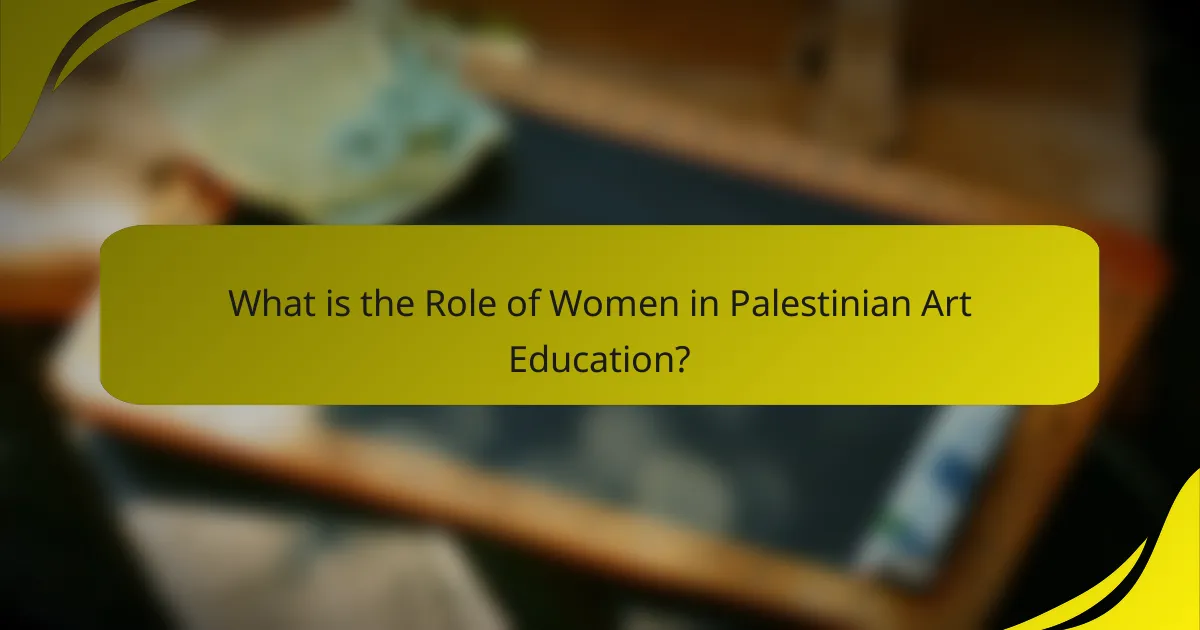
What is the Role of Women in Palestinian Art Education?
Women play a crucial role in Palestinian art education. They contribute as educators, artists, and advocates for cultural expression. Women have historically faced challenges in accessing educational resources. Despite these obstacles, they have pioneered initiatives to promote art education. Female artists often use their work to address social and political issues. They create platforms for dialogue and expression among communities. Research indicates that women’s involvement enriches the artistic landscape in Palestine. Their contributions foster resilience and cultural identity through art.
How have women contributed to the development of art education in Palestine?
Women have significantly contributed to the development of art education in Palestine. They have played crucial roles as educators, artists, and advocates for art in schools. Many women established art programs and workshops that focus on cultural expression. They emphasized the importance of art as a means of resistance and identity. Notable figures include Hanan al-Shaykh, who integrated art into community education. Women have also faced challenges such as limited resources and societal expectations. Despite these obstacles, their resilience has fostered a growing appreciation for art education. Their contributions have helped shape a vibrant artistic community in Palestine.
What are the historical milestones achieved by women in this field?
Women in Palestinian art education have achieved significant historical milestones. In the early 20th century, women began to establish art schools and community programs. Notable figures like Kamal Boullata and Laila Shawa paved the way for female artists. In 1991, the first all-female art exhibition took place in Palestine, showcasing women’s contributions. The establishment of the Women’s Art Center in 2005 provided a platform for female artists. In 2010, women artists gained international recognition through exhibitions in Europe and the US. These milestones highlight women’s resilience and creativity in the face of societal challenges.
How have women’s roles evolved in Palestinian art education over time?
Women’s roles in Palestinian art education have evolved significantly over time. Initially, women’s participation was limited due to societal restrictions. In the late 20th century, women began to gain more access to art education. This shift was influenced by broader social changes and movements for gender equality. Female artists and educators emerged as key figures in this transformation. They contributed to curriculum development and established art programs. Today, women play a vital role in shaping the contemporary art scene in Palestine. Their contributions are recognized in various exhibitions and educational institutions. This evolution reflects a broader recognition of women’s potential in the arts.
What challenges do women face in Palestinian art education?
Women in Palestinian art education face significant challenges. These include societal norms that often prioritize traditional roles over creative pursuits. Limited access to resources and funding restricts opportunities for women artists. Additionally, cultural expectations can discourage women from pursuing higher education in art. Gender discrimination in academic settings further exacerbates these issues. Studies show that women are underrepresented in art institutions and exhibitions. Economic constraints also limit women’s ability to participate fully in art education. Overall, these challenges hinder the development and recognition of female artists in Palestine.
What societal and cultural barriers impact women’s participation in art education?
Societal and cultural barriers significantly impact women’s participation in art education. Traditional gender roles often discourage women from pursuing artistic careers. Societal expectations emphasize domestic responsibilities over professional aspirations for women. Cultural norms may prioritize male artistic contributions, marginalizing women’s work. Limited access to resources and funding affects women’s ability to engage in art education. Additionally, lack of representation in art institutions can create an unwelcoming environment for female artists. Studies indicate that female artists often face discrimination and bias in educational settings. These barriers collectively hinder women’s full participation and recognition in the art education field.
How do economic factors influence women’s involvement in this field?
Economic factors significantly influence women’s involvement in Palestinian art education. Limited financial resources can restrict access to educational opportunities for women. Economic instability in the region often results in prioritization of family income over education. Many women face challenges in securing funding for art programs or materials. The lack of economic support can lead to fewer women pursuing careers in art education. Additionally, cultural expectations may pressure women to focus on domestic roles rather than professional development. Statistics show that regions with higher economic support for education see increased female participation. Economic empowerment initiatives can enhance women’s roles in the art education sector.
What are the contributions of women to Palestinian art education?
Women have significantly contributed to Palestinian art education through teaching, mentorship, and cultural preservation. They have played pivotal roles as educators in various institutions. Many women have pioneered art programs that incorporate local heritage and contemporary issues. Their contributions enhance the representation of female perspectives in art. Women artists often lead workshops that empower young female students. They also promote community engagement through collaborative art projects. Additionally, women have been instrumental in establishing art galleries and cultural centers. These spaces provide platforms for showcasing local talent and fostering artistic dialogue.
What unique perspectives do women bring to artistic practices and teachings?
Women bring diverse perspectives to artistic practices and teachings that often emphasize collaboration, community, and emotional expression. Their experiences shape their artistic narratives and methodologies. Women artists frequently challenge traditional norms and push boundaries in their work. This leads to innovative approaches that reflect social issues and personal stories. Research shows that female artists often focus on themes of identity, resilience, and cultural heritage. For instance, studies highlight how women in Palestinian art incorporate their cultural context into their work. Their contributions enrich the artistic landscape and provide new insights into the human experience. This unique perspective fosters inclusivity and encourages dialogue within the art community.
How have women’s initiatives shaped the landscape of art education in Palestine?
Women’s initiatives have significantly shaped the landscape of art education in Palestine. These initiatives have fostered creativity and provided platforms for women’s voices. Organizations led by women have established art programs and workshops. They focus on empowering female artists and educators. This has led to increased participation of women in the arts. Notable projects include community art centers and collaborative exhibitions. These initiatives have also challenged traditional gender roles in Palestinian society. The result is a more inclusive and diverse art education environment.
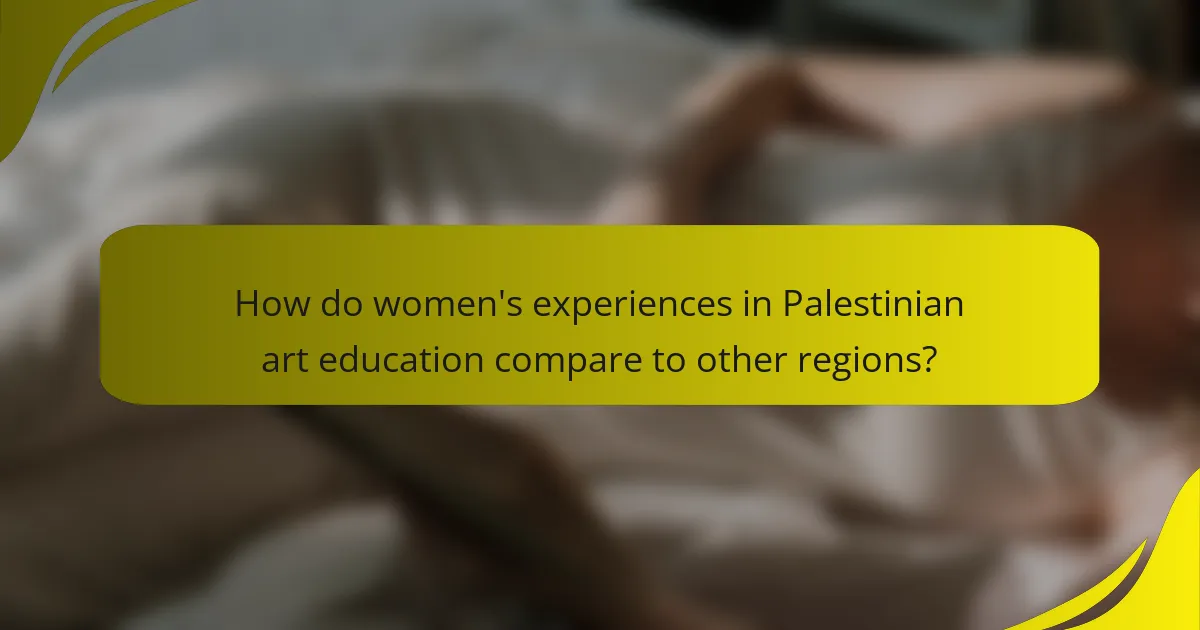
How do women’s experiences in Palestinian art education compare to other regions?
Women’s experiences in Palestinian art education are shaped by unique sociopolitical challenges. Compared to other regions, Palestinian women face restrictions due to ongoing conflict and cultural norms. These factors often limit access to resources and opportunities in art education. In many Western countries, women generally enjoy greater freedom and institutional support in pursuing art education. Research indicates that Palestinian women often navigate additional barriers such as social stigma and limited funding. Their resilience leads to innovative expressions in their art, reflecting their lived experiences. This contrasts with women in regions with more stable environments, who may focus on different themes in their art. Overall, Palestinian women’s experiences in art education highlight both struggle and creativity in response to their circumstances.
What similarities and differences exist in women’s roles in art education globally?
Women’s roles in art education globally exhibit both similarities and differences. Commonly, women contribute significantly as educators and artists across various cultures. They often face challenges such as gender bias and limited access to resources. In many regions, women lead initiatives to promote art education and empower other women. However, the degree of recognition and support varies widely. In some countries, women are celebrated as pioneers in art education, while in others, their contributions remain undervalued. For instance, in Western nations, there is a strong presence of women in art faculties. Conversely, in regions with conservative cultural norms, women’s participation is restricted. Thus, while the impact of women in art education is universally acknowledged, the context and recognition of their roles differ significantly.
How can we learn from the experiences of women in art education from other cultures?
We can learn from the experiences of women in art education from other cultures by analyzing their unique challenges and successes. Different cultural contexts shape women’s access to education and artistic expression. For instance, women in countries like Japan and Mexico have navigated societal barriers to establish significant art movements. Their experiences highlight the importance of community support and mentorship in fostering female artists. Research indicates that women in art education benefit from collaborative networks, which can enhance creativity and resilience. By studying these models, we can identify effective strategies to promote inclusivity and support for women in Palestinian art education.
What strategies can be implemented to support women in Palestinian art education?
Implementing strategies to support women in Palestinian art education involves several key actions. First, establishing scholarships specifically for women can alleviate financial barriers. This approach encourages more women to pursue art education. Second, creating mentorship programs connects aspiring female artists with established professionals. This guidance fosters skill development and confidence. Third, organizing community workshops promotes collaboration and sharing of artistic techniques among women. This builds a supportive network. Fourth, advocating for inclusive curricula that highlight female artists can inspire students. This recognition validates women’s contributions to the art field. Fifth, providing access to resources such as art supplies and studio space is essential. This enables women to practice and create freely. Lastly, promoting exhibitions that feature women artists raises visibility and appreciation for their work. These strategies collectively enhance opportunities for women in Palestinian art education.
What initiatives have proven successful in empowering women artists and educators?
Successful initiatives empowering women artists and educators include mentorship programs, grants, and community art projects. Mentorship programs connect experienced artists with emerging female talent, fostering skills and confidence. Grants provide financial support specifically for women-led artistic endeavors, enabling creative freedom. Community art projects encourage collaboration among women, enhancing visibility and representation in the arts. Organizations like the Palestinian Art Academy have implemented these initiatives, showcasing the impact on women’s roles in art education. Data shows increased participation of women in art exhibitions and educational workshops as a result.
How can community support enhance women’s contributions to art education?
Community support can significantly enhance women’s contributions to art education by providing resources, mentorship, and visibility. Access to funding and materials enables women to create and share their work. Mentorship programs connect aspiring female artists with experienced educators, fostering skill development. Community events and exhibitions showcase women’s artwork, increasing their recognition. Collaborative projects can amplify women’s voices in the art community. Research shows that women who receive community support are more likely to pursue careers in art education. For example, a study by the National Endowment for the Arts highlights the positive impact of community engagement on female artists’ success.
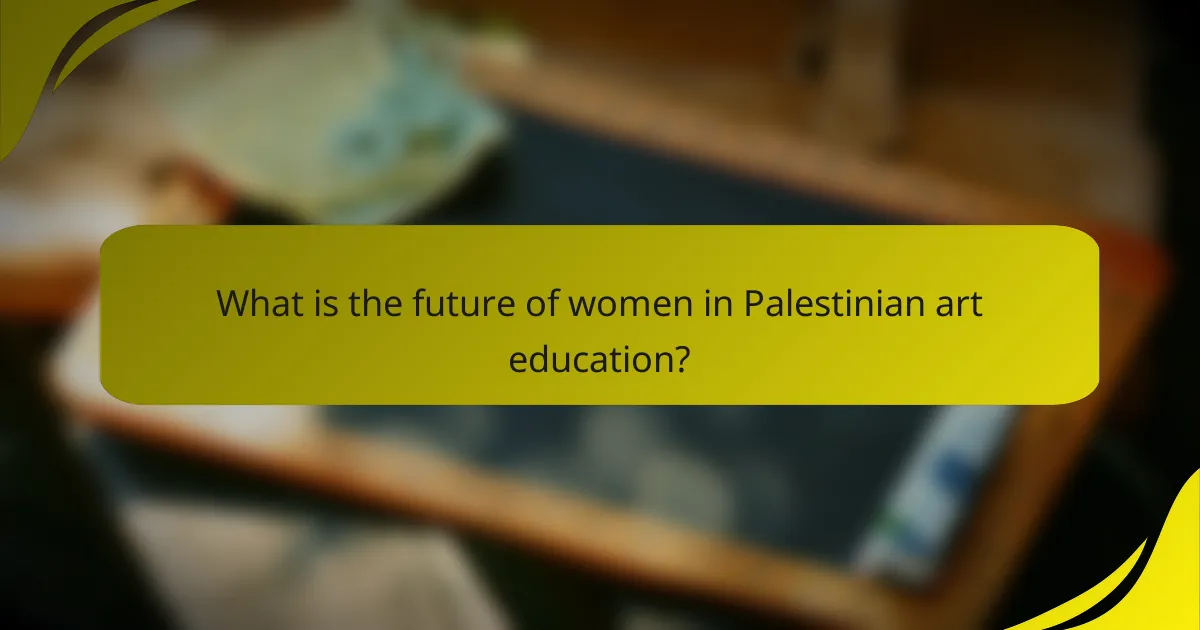
What is the future of women in Palestinian art education?
The future of women in Palestinian art education is increasingly promising. More women are pursuing higher education in art-related fields. Institutions are beginning to support female artists and educators more actively. Initiatives focusing on gender equality are gaining traction. These efforts aim to break down traditional barriers. Increased visibility of female artists enhances opportunities for mentorship. Collaborative projects are fostering a supportive community. This shift is reflected in growing participation rates among women in art exhibitions and educational programs.
What trends are emerging in the field that may affect women’s roles?
Emerging trends in Palestinian art education indicate a growing recognition of women’s contributions. Increased access to education for women enhances their roles in the field. Digital platforms are providing women with new avenues for sharing their art and perspectives. Collaborative projects are fostering community engagement and mentorship among women artists. Additionally, the rise of feminist art movements is challenging traditional narratives. These shifts are empowering women to assert their identities and influence within the art community. Research shows that women-led initiatives are gaining visibility and support, further solidifying their presence in the field.
How can technology and social media influence women’s participation in art education?
Technology and social media can significantly enhance women’s participation in art education. They provide platforms for sharing artwork and educational resources. Women can connect with mentors and peers globally. This connectivity fosters collaboration and inspiration. Online courses and tutorials make art education more accessible. Social media campaigns can raise awareness about women’s contributions in art. Statistics show an increase in female enrollment in online art programs. A report by UNESCO highlights the positive impact of digital platforms on women’s educational opportunities.
What practical steps can be taken to strengthen the role of women in this field?
Increase mentorship programs for women in Palestinian art education. These programs can provide guidance and support. Develop scholarship opportunities specifically for female art students. Financial assistance can encourage more women to pursue art education. Promote female role models in the art community. Highlighting their achievements can inspire others. Create collaborative projects that include women artists. This fosters a sense of community and shared learning. Organize workshops focused on skills development for women. Practical training can enhance their capabilities in the field. Advocate for policy changes that support gender equality in educational institutions. This can lead to more inclusive environments for female artists.
What resources are available for women pursuing careers in Palestinian art education?
Women pursuing careers in Palestinian art education have access to various resources. These include educational institutions that offer specialized programs in art and education. Organizations such as the Palestinian Art Academy provide training and workshops specifically for women. Additionally, grants and scholarships are available from local and international NGOs to support women’s education in the arts. Networking opportunities through art exhibitions and community events also help women connect with mentors in the field. Furthermore, online platforms and social media groups offer spaces for collaboration and sharing resources. These initiatives aim to empower women and promote their contributions to Palestinian art education.
How can mentorship programs benefit aspiring women artists and educators?
Mentorship programs can significantly benefit aspiring women artists and educators by providing guidance and support. These programs connect mentees with experienced professionals in their field. This relationship fosters skill development and enhances confidence. Mentorship also offers networking opportunities that can lead to collaborations and career advancements.
Research indicates that women in mentorship roles often report higher job satisfaction and personal growth. According to a study published in the Journal of Educational Psychology, mentorship leads to improved academic performance and professional success for women in education. Such programs specifically address challenges faced by women in the arts, including gender bias and limited access to resources. By empowering women through mentorship, these initiatives contribute to a more inclusive and diverse art education landscape.
The primary entity of this article is “Women in Palestinian Art Education.” The article provides an overview of the significant role women play as educators, artists, and advocates within this field, highlighting their contributions to cultural expression despite facing various challenges such as limited resources and societal expectations. It outlines historical milestones achieved by women, the evolution of their roles over time, and the unique perspectives they bring to artistic practices. Additionally, the article discusses the societal and economic barriers impacting women’s participation, successful initiatives empowering them, and the promising future trends in Palestinian art education.
